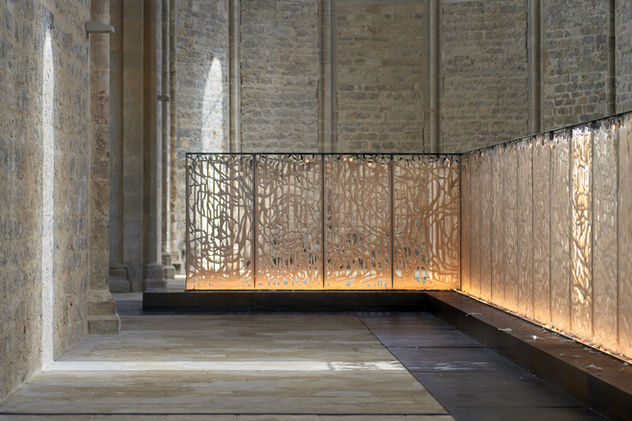
La Croix, veillée aux épines
Exposition personnelle
cire, acier, mèches, éclairage leds
L.28 m, l.11 m, h.2,25 m
wax, steel,wicks, leds
Abbaye de Beaulieu en Rouergue, Ginals, France
2023
Dans le cadre du programme de soutien à la création artistique du ministère de la Culture «Mondes nouveaux», le Centre des monuments nationaux présente une installation monumentale de l’artiste Juliette Minchin créée in situ pour l’abbaye de Beaulieu-en-Rouergue. Disposée à la croisée du transept entre la nef et le chœur, la sculpture en forme de croix de 28 mètres de long répond au plan en croix latine de l’abbatiale. Elle est composée de 33 panneaux en acier ajouré recouverts de cire, où 363 mèches sont allumées tour à tour. Tel un immense cierge, l’installation évolue au fil de l’exposition et révèle progressivement sa structure métallique.
« L’œuvre est un véritable monolithe de cire et d’acier. Un mausolée, un monument votif, peut-être aussi une grotte. En s’inspirant d’une ciergerie sicilienne, Juliette Minchin a adapté la technique de la «plongée» par laquelle, minute après minute, millimètres après millimètres, les mèches des cierges sont recouvertes de cires et refroidies, allant s’épaississant, pour l’employer à la construction de véritables parois de cire.
Le motif métallique de leur cadre est un bouquet de roses allongées qui rend hommage aux rosaces de l’Abbaye de Beaulieu. Mais patience ! Car ce n’est qu’à la consumation de ce cierge monumental que la structure se dévoile. La cire sculptait le métal au moment de la plongée, par la concrétion de ses gouttes. En fondant, elle devient vêtement architectural, peau de l’œuvre, linceul de la croix.
Tel un sablier, l’œuvre évoque l’écoulement du temps, la répétition patiente et minutieuse des mêmes gestes qui forment à la fois des techniques immémoriales et des rites disparus. Telle l’eau miraculeuse, la cire fondue sera récupérée à la fin de l’exposition afin d’être intégrée au réservoir initial et l’œuvre sera réactivée lors de sa prochaine exposition. La cire retournera à la cire, suivant le motif de l’éternel retour, fait pour conjurer les peurs de ceux qui restent, les peurs de l’après. »
Ronan Grossiat
As part of the French Ministry of Culture's "Mondes nouveaux" program to support artistic creation, the Centre des monuments nationaux is presenting a monumental installation by artist Juliette Minchin, created in situ for Beaulieu-en-Rouergue Abbey. Positioned at the transept crossing between the nave and the choir, the 28-metre-long cross-shaped sculpture responds to the Latin cross plan of the abbey church. It is composed of 33 openwork steel panels covered in wax, where 363 wicks are lit in turn. Like a huge candle, the installation evolves throughout the exhibition, gradually revealing its metal structure.
"The work is a veritable monolith of wax and steel. A mausoleum, a votive monument, perhaps even a grotto. Inspired by a Sicilian waxworks, Juliette Minchin has adapted the "plunging" technique whereby, minute by minute, millimetre by millimetre, the wicks of the candles are covered with wax and cooled, thickening as they go, for use in the construction of real wax walls.
The metallic motif of the frame is a bouquet of elongated roses, a tribute to the rose windows of Beaulieu Abbey. But be patient! Because it's only when this monumental candle is consumed that the structure reveals itself. The wax sculpted the metal as it was immersed, through the concretion of its drops. As it melts, it becomes an architectural garment, the skin of the work, the shroud of the cross.
Like an hourglass, the work evokes the passage of time, the patient, meticulous repetition of the same gestures that form both immemorial techniques and vanished rites. Like miraculous water, the melted wax will be recovered at the end of the exhibition and returned to the original reservoir, where it will be reactivated the next time it is shown. The wax will return to the wax, following the motif of the eternal return, made to ward off the fears of those who remain, the fears of the after."
Ronan Grossiat
Photographies © Damien Aspe
Video © Alexandre Attias









